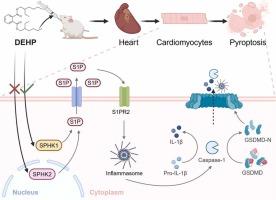dehp诱导心脏毒性机制的新认识:通过破坏鞘脂代谢触发心肌细胞焦亡
IF 11.3
1区 环境科学与生态学
Q1 ENGINEERING, ENVIRONMENTAL
引用次数: 0
摘要
邻苯二甲酸二(2-乙基己基)酯(DEHP)作为增塑剂的广泛使用引起了人们对其环境持久性和心脏毒性的关注。然而,DEHP诱导心脏损伤的确切机制,特别是心肌损伤的机制,仍然没有得到充分的了解。使用小鼠模型,本研究采用UPLC-MS/MS证明暴露于DEHP可显著提高其主要代谢物邻苯二甲酸单(2-乙基己基)酯(MEHP)在心脏组织中的浓度,而DEHP本身没有表现出显著差异。dehp诱导的小鼠心肌损伤表现为心肌纤维紊乱、胶原沉积、血清肌酸激酶- mb (CK-MB)和c反应蛋白(CRP)升高。通过数据库筛选和实验验证进一步分析表明,DEHP通过激活鞘磷脂激酶1 (SPHK1)/鞘磷脂1-磷酸受体2 (S1PR2)轴的鞘脂代谢途径介导心肌损伤。分子对接和细胞热移实验(CETSA)证实MEHP可以直接结合SPHK1并增强其稳定性。DEHP暴露也增加了热降解相关蛋白,可通过SPHK1抑制剂PF543或S1PR2 siRNA逆转。综上所述,本研究首次将dehp诱导的小鼠心脏焦亡与SPHK1/S1PR2信号传导联系起来,为dehp相关的心脏毒性研究提供了新的见解,从而为dehp相关的心脏毒性研究提供了新的理论见解。本文章由计算机程序翻译,如有差异,请以英文原文为准。

A New Insight into the Mechanism of DEHP-Induced Cardiotoxicity: Triggering pyroptosis of cardiomyocytes by disrupting sphingolipid metabolism
The widespread use of di(2-ethylhexyl) phthalate (DEHP) as a plasticizer raises concerns due to its environmental persistence and cardiotoxicity. Nevertheless, the precise mechanisms through which DEHP induces cardiac damage, particularly concerning myocardial injury, remain inadequately understood. Using a mouse model, this investigation employed UPLC-MS/MS to demonstrate that exposure to DEHP significantly elevated the concentration of its primary metabolite, mono(2-ethylhexyl) phthalate (MEHP), in cardiac tissue, while DEHP itself did not exhibit a significant difference. DEHP-induced myocardial injury in mice was evidenced by disorganized myocardial fibers, collagen deposition and elevated serum creatine kinase-MB (CK-MB) and C-reactive protein (CRP). Further analysis through database screening and experimental validation indicated that DEHP mediates myocardial injury by activating the sphingolipid metabolic pathway involving the sphingosine kinases 1 (SPHK1)/ sphingosine 1-phosphate receptor 2 (S1PR2) axis. Molecular docking and cellular thermal shift assays (CETSA) confirmed that MEHP could directly bind to and enhance the stability of SPHK1. DEHP exposure also increased pyroptosis-related proteins, reversible via SPHK1 inhibitor PF543 or S1PR2 siRNA. In conclusion, this study first links DEHP-induced cardiac pyroptosis to SPHK1/S1PR2 signaling in mice, providing novel insights into DEHP-associated cardiotoxicity, contributing to cardiac damage and thereby offering new theoretical insights into DEHP-related cardiac toxicity.
求助全文
通过发布文献求助,成功后即可免费获取论文全文。
去求助
来源期刊

Journal of Hazardous Materials
工程技术-工程:环境
CiteScore
25.40
自引率
5.90%
发文量
3059
审稿时长
58 days
期刊介绍:
The Journal of Hazardous Materials serves as a global platform for promoting cutting-edge research in the field of Environmental Science and Engineering. Our publication features a wide range of articles, including full-length research papers, review articles, and perspectives, with the aim of enhancing our understanding of the dangers and risks associated with various materials concerning public health and the environment. It is important to note that the term "environmental contaminants" refers specifically to substances that pose hazardous effects through contamination, while excluding those that do not have such impacts on the environment or human health. Moreover, we emphasize the distinction between wastes and hazardous materials in order to provide further clarity on the scope of the journal. We have a keen interest in exploring specific compounds and microbial agents that have adverse effects on the environment.
 求助内容:
求助内容: 应助结果提醒方式:
应助结果提醒方式:


